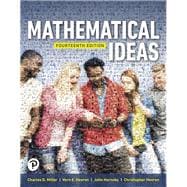NOTE: This loose-leaf, three-hole punched version of the textbook gives you the flexibility to take only what you need to class and add your own notes – all at an affordable price. For loose-leaf editions that include MyLab™ or Mastering™, several versions may exist for each title and registrations are not transferable. You may need a Course ID, provided by your instructor, to register for and use MyLab or Mastering products.
For courses in Liberal Arts Mathematics.
Engages non-STEM students with a practical presentation that connects mathematics to their current and future lives
Mathematical Ideas is a versatile text that has evolved to meet changing curricular needs and trends, but remains steadfast to its primary objectives — comprehensive coverage, appropriate organization, clear exposition, abundant examples, and well-planned exercise sets with numerous applications.
With a fresh focus on math in the workplace, this program shows students in liberal arts and survey courses how math will play an important role in their futures, while helping them to develop a solid understanding of mathematical concepts. The 14th Edition updates and enhances the text’s hallmark features, and expands its robust MyLab™ Math course to include StatCrunch® applets, animations, corequisite course material, new section lecture videos, and much more.
Also available with MyLab Math
MyLab Math is the teaching and learning platform that empowers you to reach every student. By combining trusted author content with digital tools and a flexible platform, MyLab Math personalizes the learning experience and improves results for each student. Learn more about MyLab Math.
Note: You are purchasing a standalone product; MyLab Math does not come packaged with this content. Students, if interested in purchasing this title with MyLab Math, ask your instructor to confirm the correct package ISBN and Course ID. Instructors, contact your Pearson representative for more information.










